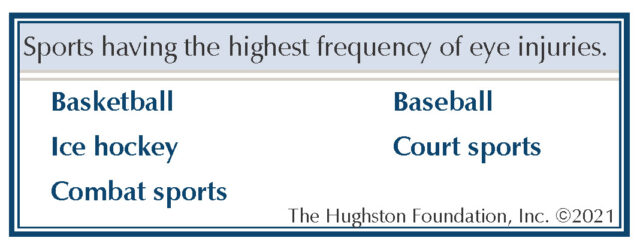
Most athletes practice injury prevention to some extent by stretching or wearing protective gear such as pads or helmets. Although athletes use basic prevention techniques out of habit or sport requirement, how much thought goes into protecting your eyes?
Athletes often overlook eye protection, although injuries to your eyes have consequences that affect more than just your sport involvement. Eye injuries can range from mild to severe and can interfere with participation in school and work-related activities. Additionally, serious eye injuries can have long-lasting effects on your social, psychological, and occupational wellbeing.
Just the facts
Annually, there are over 600,000 sports-related eye injuries. Of those, 42,000 require emergency room evaluation and 13,500 result in permanent loss of sight. These numbers roughly translate to 1 sports-related eye injury seen by an ER physician every 13 minutes. Eye injuries are the leading cause of blindness in children and sports are the leading cause of eye injuries in children under the age of 16. Treatment of sports-related eye injuries cost on average $175 to $200 million each year. Of all eye injuries, 90% could be prevented with appropriate protection.

Types of injuries
Most eye injuries that occur during sporting activity can be classified as blunt, penetrating, or radiation injuries. Blunt, or impact, injuries occur from a direct blow to your eye. These injuries can be caused by equipment, such as a ball, stick, or racket, or by another athlete. Injuries can range from a bruised or black eye to an orbital fracture (broken eye socket bone). Penetrating, or piercing, injuries occur when an object cuts into or pierces the globe of your eye. Sharp objects such as broken glass, fishing hooks, debris, or fingernails can cause these types of injuries. Penetrating injuries can be severe and require immediate medical evaluation. Radiation eye injuries, caused by intense sunlight, are common in water and snow sports. Goggles, sport glasses, or face shields can help protect your eyes from blunt or penetrating injuries and wearing eyewear with SPF protection will protect your eyes from radiation.
What are the most common sports-related eye injuries?
Corneal abrasions are scrapes or scratches to the surface layer of your eye. They often heal by themselves, but can be treated with antibiotic drops to prevent infection.
Traumatic iritis is inflammation within the iris that occurs after blunt trauma. Traumatic iritis is treated with steroid drops and medication to dilate the pupil.
Traumatic hyphema, or blood in the front chamber of the eye, is a serious injury that requires immediate evaluation because it can result in a permanent loss of vision.
Orbital fractures are breaks in the bones that surround your eye socket. These types of fractures require further evaluation for associated injuries and sometimes need surgery to heal.

When should you seek medical attention?
Often, eye injuries can be treated at home, but a physician or other healthcare provider should immediately assess any penetrating eye injury. Other signs and symptoms that can indicate a serious injury are: sudden decrease or loss of vision, pain with eye movement, light sensitivity (photophobia), double vision, protrusion of the eye, lightning flashes, an irregularly shaped pupil, foreign body sensation, red eye, and blood in the front chamber of the eye.
Prevention
You can prevent an injury by wearing protective eyewear, but not all eyewear is protective. Contact lenses offer no protection and street-wear glasses and sunglasses can be more dangerous since they can break and cause a penetrating eye injury. The lenses in protective eyewear are made of polycarbonate, which is a versatile tough plastic that is 20 times stronger than regular lenses. It can withstand the force of a projectile traveling 90 miles per hour. The frames in protective eyewear must be sturdy and contain a posterior rim so that the lens cannot dislodge backward into your eye. The frames themselves can also be made of polycarbonate. For the best result, a licensed optometrist or optician should fit your protective eyewear.
Author: Jaclyn Jones, DO | Columbus, Georgia
Last edited on November 9, 2021